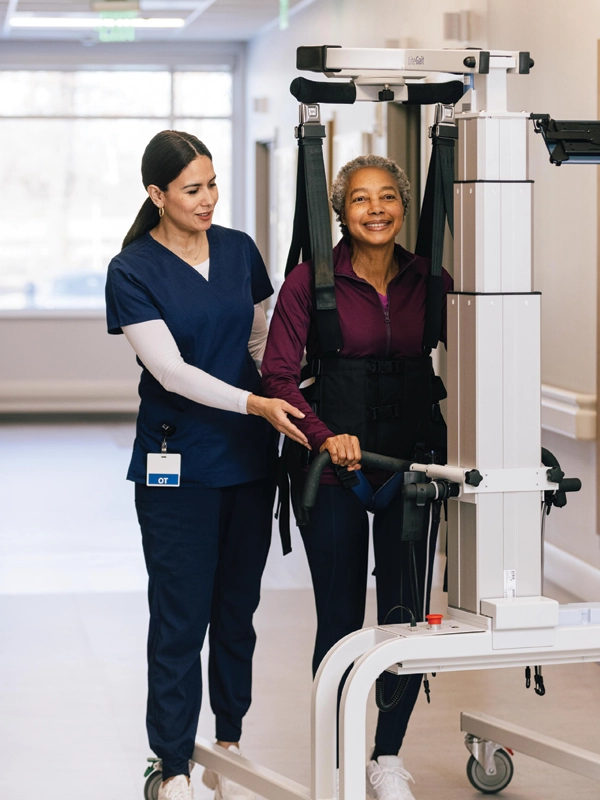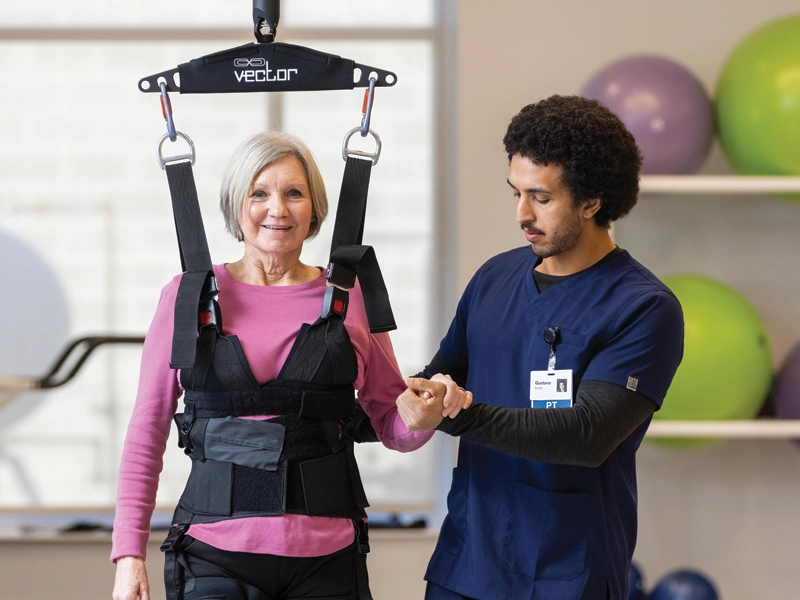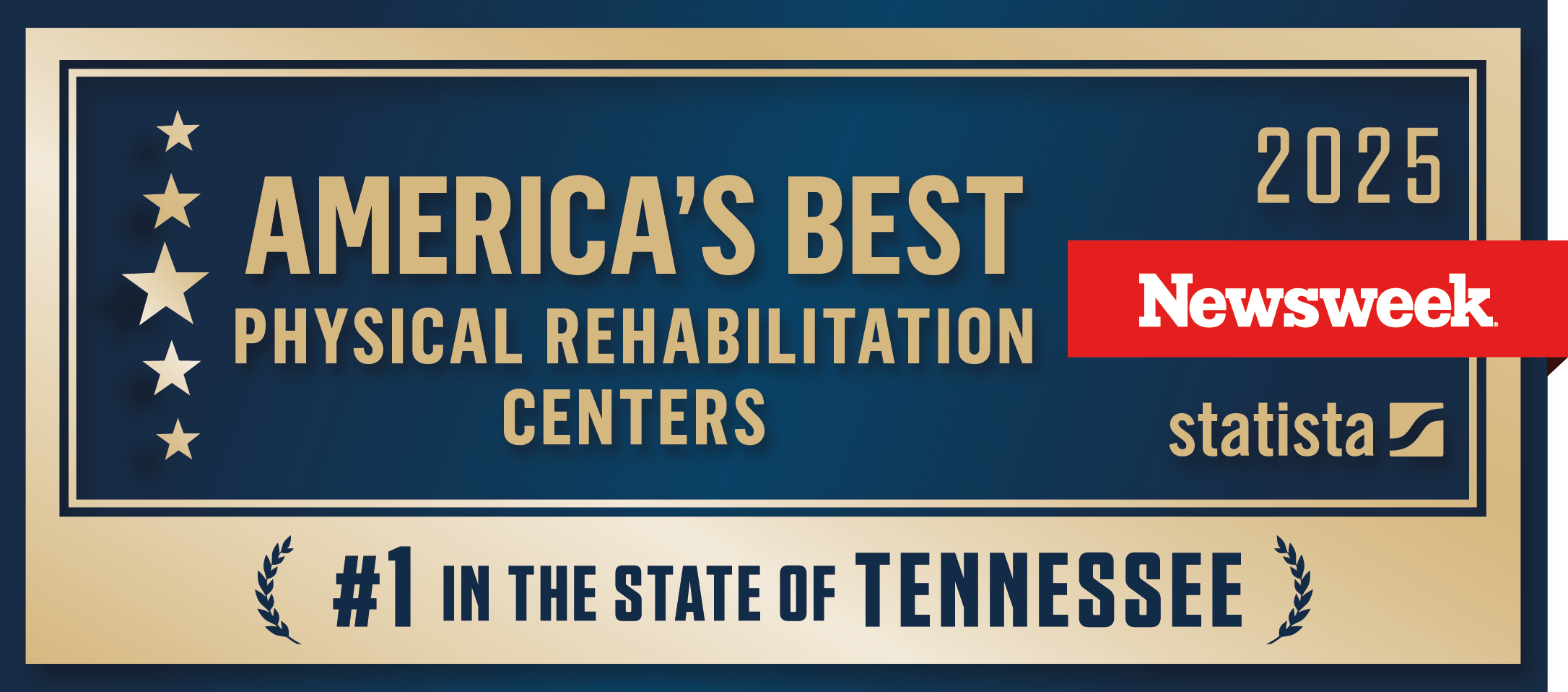Therapeutic Technology
Our hospital provides such leading-edge technology – as well as therapists trained to use it best – to ensure our patients are positioned to recover as quickly as possible.
Innovative Solutions for Superior Outcomes
New technology continues to push the boundaries of what once was considered full recovery from certain injuries or conditions. Today, for instance, top inpatient rehabilitation facilities deploy robotic tools that give stroke patients the ability to use their upper extremities again or help spinal cord injury patients with early ambulation.
Our hospital provides such leading-edge technology – as well as therapists trained to use it best – to ensure our patients are positioned to recover as quickly as possible.
Here are some examples of some of the industry’s best technology deployed at our hospital:
LiteGait®
LiteGait® is a body-weight support system and gait training device that provides a safe environment for patients to participate in gait training over a treadmill or over the ground. This system allows patients to begin gait training earlier in the rehabilitation process and at a lower level than would be feasible with any other assistive device available. The LiteGait system eliminates the fear of falling and/or loss of balance with standing and walking tasks and allows the therapist the ability to provide manual assistance to the legs and pelvis throughout the gait cycle to facilitate proper gait patterns.

Overhead Body Weight Support System
Our overhead body weight support system provides dynamic body weight support while patients practice walking, balance tasks, sit-to-stand transfers, open and closed-chain strengthening exercises, and even steps. This system is mounted to an overhead track, allowing for use within the parallel bars or outside of the bars when introducing an assistive device during gait training progression. The body weight support system provides a safe environment for patients to begin standing, transfer, and gait training.

SaeboMAS
The SaeboMAS is a zero-gravity upper extremity device used to facilitate or challenge the weakened shoulder during functional tasks, such as eating or combing your hair. This device is used with patients with neurological and orthopedic conditions resulting in shoulder weakness. The adjustable spring-based tension system offers variable levels of assistance as the patient’s strength improves and makes it easy to track and document progress. It can be used to increase strength, range of motion, and motor control and encourage neuroplasticity by allowing the opportunity for highly repetitive tasks.
InMotion
The BIONIK InMotionARM™ Robot is often used with many patients who suffer from weakness in their upper extremities after a stroke. The ARM Robot helps patients utilize their strength to complete hundreds of repetitions in a fraction of the time of traditional exercise. Repetition is one of the most important factors when considering neuroplasticity and the brain’s ability to repair and relearn movements following a stroke. This evidence-based neurorehabilitation technology quietly monitors the patient’s movements during therapy while gently assisting where needed to help them complete various motor therapy activities.

EksoGTTM
The EksoGT™ exoskeletal unit assists patients with early ambulation following a stroke or spinal cord injury. Ekso is a robotic exoskeleton that can be fitted to most patients to allow them to stand and ambulate early in the rehab process, which is key to their long-term prognosis. Clinical evidence indicates that gait training in the Ekso improves patients’ balance, walking distance, and gait speed outside of the device at discharge compared to admission.

RehabTracker
RehabTracker is a groundbreaking person-centered mobile app that is transforming how our partners engage with patients and their families. Combined with our approach of focusing our care around What Matters to You (the patient), RehabTracker allows patients and their invited loved ones to view their personalized goals, see and track their patient progress in real-time as logged by our therapists, including overall progress toward discharge goals, activities of daily living, distance and transfers, share that progress with invited family and friends, share patient photos during their recovery journey, receive comments from staff and messages of support from loved ones – all from the palm of their hands. Areas of patient progress include self-care activities such as bathing, dressing, and eating, mobility activities including walking, transfers, and bed mobility, speech-language activities including expression and comprehension, memory and problem-solving, and diet/swallowing food and liquid consistencies. Facilities utilizing RehabTracker have experienced greater levels of patient motivation as well as patient and family member engagement and satisfaction.
OmniCycle® Motorized Cycling Machine
- Provides passive, active-assist, and active exercises for upper and lower extremities
- For orthopedic, cardiac, and neurological patients
- It allows a very weak individual to exercise for longer periods of time, gaining proper repetition and motor learning
- It provides a biofeedback feature that assists the patient’s learning and is a key part of the preparation for active walking and functional performance
- Provides objective data so that the patient can follow their progress
- Evidence-based equipment that has been shown to improve strength, circulation, coordination, endurance, and spasticity management
NuStep Recumbent Cross Trainer
A recumbent cross trainer that sets an unparalleled standard for total body exercise in a comfortable seated position.
- Works all major muscle groups and gives an effective cardiovascular workout
- Allows a person to move arms and legs in a single, dependent motion that stimulates walking with the added benefit of resistance training
Biodex Balance System
A unique device that can assess nerve-muscle control by gathering information on a person’s ability to maintain balance.
- It measures balance on a firm and movable surface, stability of standing on one or both legs
- Valuable training device to improve movement abilities, especially when the proprioceptive reflex (body’s reaction and reflexes) are impaired after an injury
- It has both testing and training modes for postural stability, fall risk, and limits of stability that allow baseline data to compare as a patient improves
Bioness® H200 Wireless Hand Rehabilitation System
The H200 is used to stimulate nerves and muscles of the forearm and hand in order to regain hand function in order to increase independence with activities of daily living.
Specific goals include:
- Increase hand function
- Increase or maintain hand range of motion
- Reduce muscle spasms
- Prevent muscle loss
- Reeducate muscles
- Increase blood circulation
Mobility Garden
The mobility garden is designed to meet various therapeutic goals including mobility, cognition, emotional well-being, and gross/fine motor skills, as well as reintegrating patients into their natural environment. The mobility garden hosts a variety of walking surfaces including grass and cobblestone as well as houses a basketball court, driving range, putting green, and raised garden.
ADL suite/Transitional Living Unit
As part of our goal here at BMRH, we provide experiences to assist with reintegration into the community and home environment. The ADL suite is designed with this goal in mind. It allows patients to experience a home environment, including use of a washer/dryer, kitchen setup, regular-size bed, and a tub/ shower combination. Patients who have progressed to a higher level of independence may be given the opportunity to live in the suite for 2-3 days prior to discharge.
Swallowing Therapy
- Diners program for patients with dysphagia (chewing and swallowing disorder)
- Provides personalized therapy at breakfast and lunch every day
- Teach patients strategies/methods for safe intake
- VitalStim Therapy
- Non-invasive, external electrical stimulation therapy for the treatment of dysphagia
- Involves the use of electrodes that are applied to the neck and face in combination with swallowing exercises
- Shown to accelerate the recovery time from a restricted diet and help patients achieve sustained improvement and long-term results
Bioness® L300 Plus
An electrical stimulation machine that activates thigh and lower leg muscles to assist with control and stability during ambulation and functional tasks.
- Helps with controlling the knee and assisting with foot drop
- Research has proven it is very effective in improving walking speed and symmetry. It has reduced the step inequality by 25% during the first walk and continues to show improvement even after six weeks
- It is effective with MS, CVA, and other conditions where the motor unit is intact
Senaptec Sensory Station
The Senaptec Sensory Station is a state-of-the-art sensory evaluation and training station that accesses ten visual and sensorimotor skills. In less than 25 minutes, you can determine an individual's strengths and opportunities to improve sensory performance.




